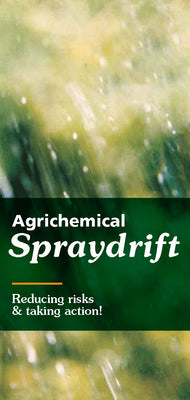Agrichemical Spraydrift - HE10108

Agrichemicals are chemicals used in agriculture. Sprays may be used to control insects or other pests, weeds, diseases, or to fertilise crops. This pamphlet deals with reducing risks and taking action if chemical spraydrift occurs.
The full resource:
Reducing Risks and Taking Action!
What is agrichemical spraydrift?
Agrichemicals are chemicals used in agriculture for various reasons. Agrichemical spray may be used to control insects or other pests, weeds, diseases, or to fertilise crops. When the spray drifts away from the target area it is known as spraydrift.
The amount of agrichemical spraydrift depends on weather conditions, the landscape (hills, shelter-belts etc), and the way the operator carries out the spraying. Operators should be following the guidelines in their Code of Practice.
Risks from spraydrift will depend on such things as the extent of the drift, the chemical used and its effects, and the strength of the spray.
If you have concerns about your health after there has been spraying in your area, contact your doctor or health professional.
What should I do if significant spraydrift occurs around my home?
Operators are encouraged to inform neighbours before they spray. This gives you a chance to:
- stop any outdoor activity, for example, children or pets playing outside
- close windows
- bring in washing from the line
- store some water in clean containers, adding ½ teaspoon household bleach per 10 litre bucket of water to keep stored water clean
- disconnect the pipes to any water tank collecting rain water from a roof
- cover fish ponds.
These actions help prevent contact with spraydrift.
If spraydrift does occur:
- shower and change your clothing if you have been exposed
- wash exposed fruit or vegetables
- if possible, do not reconnect pipes to any water tank collecting rain water from a roof until after the roof has been washed down by rainfall.
What other course of action should I take?
You can report spraydrift and have it investigated. Write down details such as:
- how you were first aware of spraydrift
- the time, date, weather (especially the wind strength and direction) and events as they happen
- the colour and smell of the spray, if obvious
- who is spraying and the equipment used
- who else is spraying in the area
- the type of aircraft (if used), its identification number and colour, the direction it came from
- an estimate of its height above ground
- any symptoms occurring after spraydrift, and time lapse between spraydrift and symptoms.
You may even be able to video or photograph what is happening.
Sensitive areas include:
- schools, kindergartens, etc
- residential areas
- playgrounds, parks, etc
- public water supply catchments
- ponds, lakes, streams, etc
- sensitive crops or farms (eg, organic)
- wetlands
- public roads.
Contacts
Report your findings to your regional, district or city council. Your council offices will have more information about agrichemicals and spraying in your district.
If spraydrift has affected your health, contact your doctor or other health professional and report the incident to the Health Protection Officer or Medical Officer of Health at your local office of the National Public Health Service (usually located through your local hospital).
Operators have a New Zealand Standard: New Zealand Standard for the Management of Agrichemicals NZS 8409:2021, which sets out guidelines for the safe and responsible use of agrichemicals. It is also the core document for the GROWSAFE Training Programme which provides guidance to ensure that agrichemicals are used in a safe, responsible and effective manner.